
Title: Ten Thousand Stitches
Series: Regency Faerie Tales #2
Author: Olivia Atwater
Publisher: Orbit
Publication date: July 19, 2022
Length: 250 pages
Genre: Fantasy
Source: Library
Regency housemaid Euphemia Reeves has acquired a faerie godfather. Unfortunately, he has no idea what he’s doing.
Effie has most inconveniently fallen in love with the dashing Mr Benedict Ashbrooke. There’s only one problem; Effie is a housemaid, and a housemaid cannot marry a gentleman. It seems that Effie is out of luck until she stumbles into the faerie realm of Lord Blackthorn, who is only too eager to help Effie win Mr Ashbrooke’s heart. All he asks in return is that Effie sew ten thousand stitches onto his favourite jacket.
Effie has heard rumours about what happens to those who accept help from faeries, but life as a maid at Hartfield is so awful that she is willing to risk even her immortal soul for a chance at something better. Now, she has one hundred days – and ten thousand stitches – to make Mr Ashbrooke fall in love and propose. . . if Lord Blackthorn doesn’t wreck things by accident, that is. For Effie’s greatest obstacle might well prove to be Lord Blackthorn’s overwhelmingly good intentions.
From the author of HALF A SOUL comes a whimsical fantasy romance with a Cinderella twist. Pick up TEN THOUSAND STITCHES, and dive into another enchanting faerie tale set in Olivia Atwater’s charming, magical version of Regency England!
In Ten Thousand Stitches, we meet hardworking housemaid Euphemia Reeves, who toils day and night to do the bidding of the awful Lady Culver. The work is never-ending and exhausting, and whenever a servant leaves (or is fired), the others simply must pick up the slack. Effie is tired, and she’s angry too — she and her friends below stairs are, at best, viewed as part of the furniture. When Lady Culver learns that a rival now has French maids, she decrees that her own maids must be French too, and promptly gives them all new names. Effie is furious — the servants count for so little that even their names are not their own.
But when Effie meets Benedict, the younger brother of Lord Culver, her world shifts sharply. He initially mistakes her for a lady, and wows her with his brief attention and kindness. Of course, later as she’s serving at a fancy ball, he looks right past her and doesn’t recognize her at all. Effie is sure that this is the man she loves, and she feels in her heart that if only she were a lady, he’d love her too.
Enter Lord Blackthorn. The kind-hearted faerie has become enamored with the idea of English virtue, and has been told that the way to attain English virtue is by helping the helpless and punishing the wicked. Who could be more helpless than downtrodden Effie? Lord Blackthorn offers her a glamour by which she’ll look and sound like a lady, and soon she finds herself moving in polite society, gaining the attention of the upper crust and getting closer and closer to Benedict’s heart.
But the more Effie sees, the more she questions her goals and desires. It also turns out that there’s a hint of magic in her fine sewing — when she sews, she imbues her stitches with her emotions… and given how angry she’s been, soon there’s a plague of anger amongst the servants.
In the world of Ten Thousand Stitches, anger is a good thing, because it leads to action. In fact, what we have here is a labor movement! Thanks to the anger Effie inadvertently spreads, the workers of the household reach the boiling point and then some, and ultimately demand action. It’s quite fun to see organized labor in a fantasy story!
The faerie tale elements work well, and while the outcome is expected, it’s quite a lark to see how we get there. Effie is a terrific main character, and I appreciate the author’s spotlight on class divisions in the world of fairy tale romances. As the author points out in her notes at the end, fairy tales with downtrodden main characters often reveal that the heroine is really a princess or lady in hiding — Cinderella herself is high-born, forced into servitude by cruelty and bad luck. But why are low-born servants treated as invisible and deemed unworthy? Why can’t a housemaid deserve her own happily ever after?
I really enjoyed Ten Thousand Stitches. It’s a bit lighter than Half a Soul, but offers some truly satisfying comeuppance for the nasty folks and great endings for the good guys. It was fun to get a glimpse of a couple of characters from Half a Soul — the books are companion pieces set in the same world, rather than connected stories, so it’s not necessary to read them in a particular order.
For anyone looking for some light fantasy entertainment — with a social conscience — the books of the Regency Faerie Tales are great choices!
I also ended up reading The Latch Key, a novella set in the world of the Regency Faerie Tales that takes place after the events of Half a Soul. This novella provides a backstory for Elias, and is worth checking out. (As far as I can see, The Latch Key is only available by signing up for the author’s newsletter, here.)



really fun review thanks
Thank you!
Ten Thousand Stitches sounds like a very fun spin on the Cinderella story.
Totally — although it’s funny, I didn’t even make the connection to Cinderella until the very end. 🙂
I didn’t know Latch Key even existed! Thanks for posting, I’m off to get it now!!!!
Yay! Have you read Lord Sorcier already? It was included in the edition of Half a Soul I read.
I’ll need to check! Thanks!